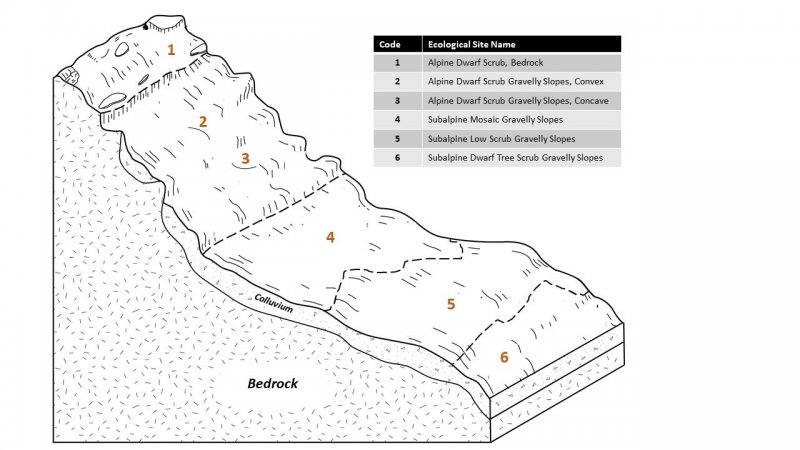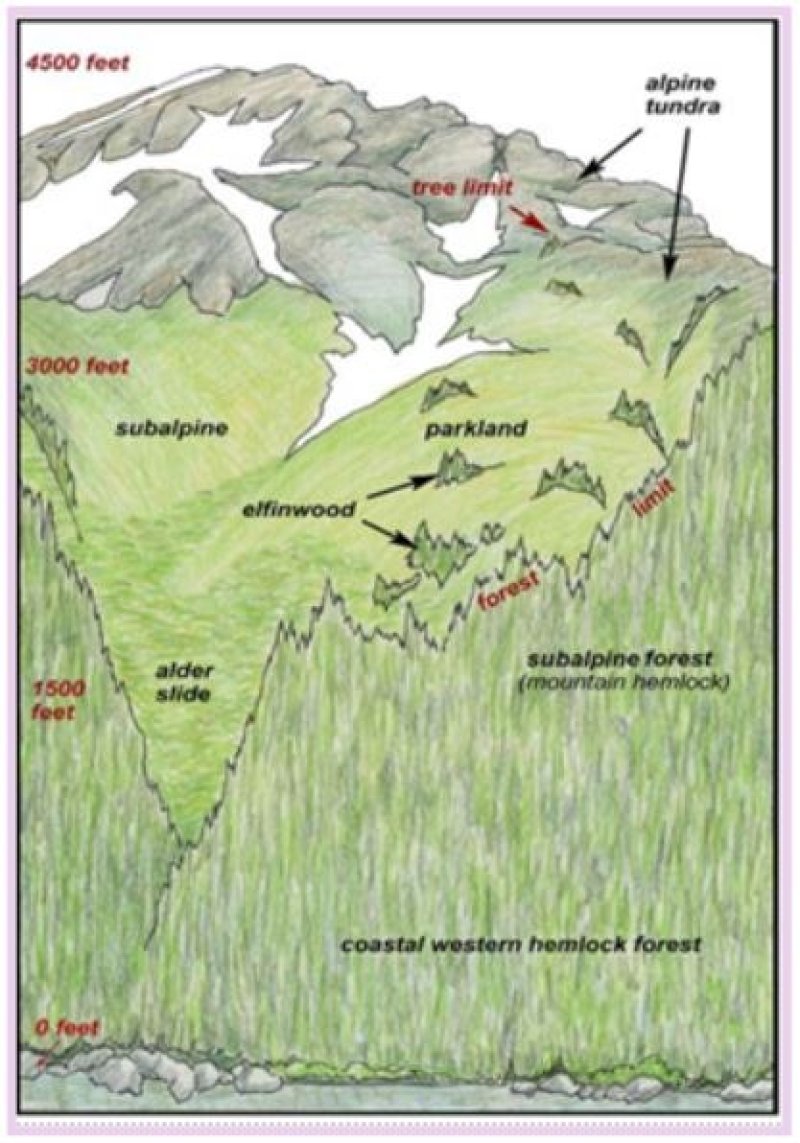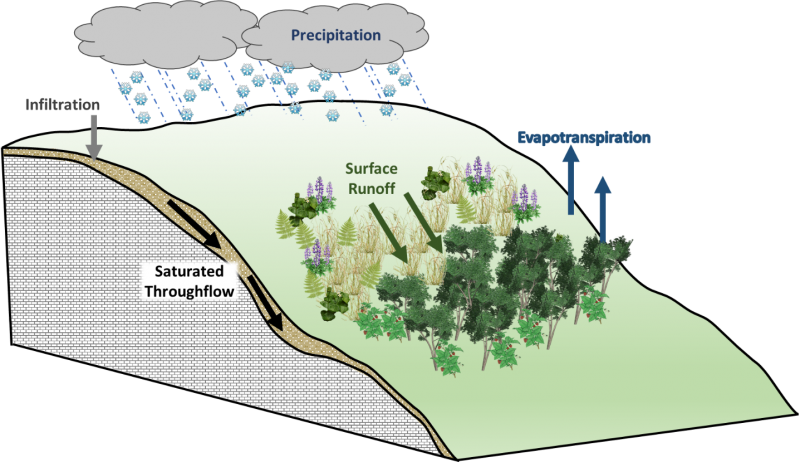
Natural Resources
Conservation Service
Ecological site R220XY358AK
Subalpine Scrub Gravelly Dry Slopes
Last updated: 6/05/2025
Accessed: 12/20/2025
General information
Provisional. A provisional ecological site description has undergone quality control and quality assurance review. It contains a working state and transition model and enough information to identify the ecological site.
MLRA notes
Major Land Resource Area (MLRA): 220X–Alexander Archipelago-Gulf of Alaska Coast
The Alexander Archipelago-Gulf of Alaska Coast area consists of a narrow arc of islands and lower elevation coastal mountains in the Southern Alaska Region. This area spans from the Alexander Archipelago in southeastern Alaska, north and west along the coast of the Gulf of Alaska and Prince William Sound, and further west to the southern tip of the Kenai Peninsula and the northeastern islands of the Kodiak Archipelago. The area makes up about 27,435 square miles (USDA 2006). The terrain primarily consists of low to moderate relief mountains that are deeply incised. Throughout the area glaciers, rivers, and streams have cut deep, narrow to broad valleys. The broader valleys have nearly level to strongly sloping flood plains and stream terraces. Alluvial and colluvial fans and short footslopes are common in the valleys along the base of the mountains. Rocky headlands, sea cliffs, estuaries, and beaches are common along the coast.
During the late Pleistocene epoch, the entire area was covered with glacial ice. The numerous fjords of the Alexander Archipelago and Prince William Sound were formed chiefly as a result of glacial scouring and deepening of preglacial river valleys. Most glacial deposits have been eroded away or buried by mountain colluvium and alluvium, which cover about 90 percent of the present landscape. The remaining glacial and glaciofluvial deposits are generally restricted to coastal areas. During the Holocene epoch, volcanic activity within and adjacent to this area deposited a layer of volcanic ash of varying thickness on much of the landscape in the southeastern and northwestern parts of the area. Paleozoic, Mesozoic, and Lower Tertiary stratified sedimentary rocks and Cretaceous and Tertiary intrusive rocks underlie much of the area and are exposed on steep mountain
slopes and ridges (USDA 2006).
The dominant soil orders in this MLRA are Spodosols, Histosols, and Entisols. Soils in the area typically have a cryic soil temperature regime, an udic moisture regime, and have mixed minerology. Spodosols are common on mountains and hills having been formed in gravelly or cobbly colluvium, glacial till, and varying amounts of silty volcanic ash. These Spodosols commonly range from shallow to deep, are well to somewhat poorly drained, and typically classify as Humicryods or Haplocryods. Histosols that are poorly to very poorly drained occur on footslopes, discharge slopes, and valley floors. These wet histosols commonly classify as Cryosaprists, Cryohemists, and Cryofibrists. Histosols that are well drained occur on steep mountainsides. These dry Histosols commonly classify as Cryofolists. Entisols are common on flood plains, stream terraces, and outwash plains having been formed in silty, sandy, and gravelly to cobbly alluvium. These Entisols are generally deep, range from well to somewhat poorly drained, and commonly classify as Cryaquents and Cryofluvents. Miscellaneous (nonsoil) areas make up about 23 percent of this MLRA. The most common miscellaneous areas are chutes, rock outcrop, rubble land, beaches, riverwash, and water.
This area represents the Northern extent of the Pacific temperate rainforest and is characterized by productive stands of conifers. Western hemlock and Sitka spruce are the dominant trees on mountains and hills at lower elevations. Due to warmer temperatures, western red cedar and Alaska cedar are more prevalent in the southern portion of this area. Black cottonwood and mixed forest types occur on flood plains. Areas of peat and other sites that are too wet for forest growth support sedge-grass meadows and low scrub. As elevation increases, mountain hemlock becomes the dominant tree in forested stands, which marks the transition to subalpine vegetation. The subalpine life zone typically occurs at elevations between 1500 to 3000 feet (Boggs et al. 2010, Carstensen 2007, Martin et al. 1995). Other common subalpine plant communities include tall alder scrub and bluejoint-forb meadows. Alpine vegetation occurs at even higher elevations, which marks the transition to the Southern Alaska Coastal Mountains Area (MLRA 222).
This area includes the Municipality of Juneau, Alaska's capital, and a number of smaller coastal towns and villages. Federally administered lands within this MLRA include Admiralty Island National Monument and part of Misty Fjords National Monument, Tongass National Forest, Chugach National Forest, and Glacier Bay, Wrangell-St. Elias, and Kenai Fjords National Parks and Preserves. The southern terminus of the Trans-Alaska Pipeline is in Valdez.
For many decades, logging, commercial fishing, and mining have been the primary industrial land uses throughout much of the area. In recent years, changes in public interests, land use policies, and timber economics have contributed to a significant decline in the timber industry. Commercial fishing continues to be an important industry and most communities support a fleet of boats and fishing related facilities. A number of mines operate in the area and others have been prospected and proposed. Tourism and wildland recreation are becoming increasingly important within the area. Subsistence hunting, fishing, and gathering provide food and a variety of other resources to local residents and remain the principal economy for residents of remote villages.
Classification relationships
USFS Ecoregion Province: Marine Mountains (M240), Forest-Meadow High (M242b) (Bailey 2007)
U.S. EPA Level III Ecoregion: Pacific Coastal Mountains (119) (Gallant et al. 2010)
National Vegetation Classification – Ecological Systems: Alaskan Pacific Maritime Mesic Herbaceous Meadow (CES204.163), Alaskan Pacific Maritime Alder-Salmonberry Shrubland (CES204.152) (NatureServe 2015)
Biophysical Settings: Alaskan Pacific Maritime Mesic Herbaceous Meadow (BpS 7816530), Alaskan Pacific Maritime Subalpine Alder-Salmonberry Shrubland (BpS 7816520) (LANDFIRE 2009)
Alaska Natural Heritage Program Landcover Class: Herbaceous (Mesic): Alpine and Subalpine Mesic Herbaceous, Low-Tall Shrub: Alder-Salmonberry (Boggs et al. 2016)
Alaskan Vegetation Classification: Mesic Sedge-Grass Meadow Tundra, Mesic Sedge-Herb Meadow Tundra, Closed Tall Alder Shrub (Viereck et al. 1992)
Ecological site concept
This subalpine site has soils prone to creep. This site occurs on mountain slopes at the highest subalpine bands of elevation before the true alpine life zone. This site occurs at a band of elevation with a harsh climate where trees are often stunted and grow in patches. The soils are dry for much of the growing season and are considered well to moderately well drained. The soils are gravelly and are typically formed in colluvium that is shallow to very deep. Since these soils are associated with creep, soils commonly have buried, mixed, and/or broken horizons. This site has a unique mosaic of tall scrub and meadow vegetation.
The reference plant community is a closed tall scrubland dominated by sitka alder and salmonberry (Landfire 2009). The understory vegetation is dominated by ferns species like common ladyfern and spreading woodfern. The meadow community is typically a mixture of grass and forb species like bluejoint, longawn sedge, fireweed, green false hellebore, and common cowparsnip (Boggs et al. 2008, Landfire 2009). The primary disturbance processes thought to maintain these plant communities are exposure to cold temperatures, soil creep that hinders tree growth and establishment, thick creeping snowpack that crushes woody vegetation, and avalanches (Carstensen 2007, NatureServe 2018).
Associated sites
| F220XY205AK |
Subalpine Woodlands Gravelly Moist Slopes Occurs on similar bands of elevation on wetter soils. |
|---|---|
| F220XY350AK |
Subalpine Woodland Gravelly Dry Slopes Occurs on similar bands of elevation on drier soils not prone to soil creep. |
| F220XY202AK |
Subalpine Woodlands Gravelly Dry Slopes, Limestone Occurs on similar bands of elevation on calcareous limestone bedrock. |
Similar sites
| F220XY350AK |
Subalpine Woodland Gravelly Dry Slopes Both sites occur in a similar band of elevation. However, F220XY350AK typically has a woodland dominated by mountain hemlock and an understory dominated by ericaceous dwarf shrubs. |
|---|---|
| F220XY205AK |
Subalpine Woodlands Gravelly Moist Slopes Both sites occur in a similar band of elevation. However, F220XY205AK typically has a woodland dominated by mountain hemlock and an understory dominated by copperbush and wetland indicators species. |
| R220XY349AK |
Subalpine Scrub Gravelly Dry Chutes Both sites have tall scrub plant communities. R220XY349AK is restricted to subalpine avalanche chutes. |
Table 1. Dominant plant species
| Tree |
Not specified |
|---|---|
| Shrub |
(1) Alnus viridis ssp. sinuata |
| Herbaceous |
(1) Dryopteris expansa |
Click on box and path labels to scroll to the respective text.
Ecosystem states
State 1 submodel, plant communities
| 1.1a | - | Avalanche and snowpack creep |
|---|---|---|
| 1.2a | - | Recolonization |


